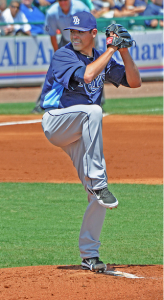It’s May. We are a month into the season, and there have been many surprises. Starling Marte is second on the player rater, and Clay Buchholz is the number one rated pitcher … Wait, that does not sound right. But it’s true.
However, while we know better than to believe that Starling Marte and Clay Buchholz will keep up their current pace, it is easy to fall into the trap of overrating a player’s April statistics. How can we avoid these pitfalls?
Well, let’s take our time, and look at pitchers. What do we know? ERA is a poor indication of a pitcher’s future performance. What else do we know? FIP is a way to more accurately predict a pitchers future production.
Below is a list of pitchers that have had the largest differential between their ERA and FIP, and have outperformed their peripherals — also known as “the luckiest pitchers.”
The Luckiest Pitchers of 2013:
The list was restricted to starters that have thrown 28 innings or more. The term FIPdif indicates the differential between the pitchers ERA and FIP. The larger the FIPdif, the more the pitcher has gotten lucky.
9. Jordan Zimmerman, FIPdif: -1.28

Matt Moore has lived up to what most prospect watchers thought he would become, but there is reason to doubt his performance. Photo by: hypersquall.
8. Jason Marquis, FIPdif: -1.49
7. Hisashi Iwakuma, FIPdif: -1.58
Make no mistake, Iwakuma has pitched spectacularly this year, but it is unlikely that he will finish where he currently ranks as the number eight starting pitcher on the player rater. While Iwakuma has a large FIPdif, that differential is largely because his ERA is so low (1.61), and not because his FIP is high (3.19). The .191 BABIP that Iwakuma currently sports will regress, and when it does, so will his ERA. But, the 8.46 K/9 and the 1.61 BB/9 are eye-popping numbers and are reasons to believe that Iwakuma will finish in the top thirty of starting pitchers, just not in the top ten.
6. Jeremy Hefner, FIPdif: -1.78
5. Jeff Locke, FIPdif: -1.91
4. Scott Feldman, FIPdif: -1.92
3. Jeremy Guthrie, FIPdif: -2.07
Guthrie is the definition of fools gold, and he could be the luckiest pitcher on this list. Guthrie’s K/9 and BB/9 are near his career averages, his BABIP is .240, and he has stranded 93.3% of runners left on base. If you can sell high on Guthrie and get an established pitcher that has struggled to this point, do it now before either pitcher makes another start.**
2. Matt Moore, FIPdif: -2.15
Moore has pitched better in some respects this year—his strike out rate is up to 9.97 K/9—but he has also pitched worse in others as well—his walk rate is also up this year to 4.62 BB/9. Moore’s BB/9 for 2013 is only better than Jon Niese, Jarrod Parker, Gio Gonzalez, Jason Marquis, and C.J. Wilson; these aren’t exactly pitchers that have pitched great. ***
1. Jake Westbrook, FIPdif: -2.48
As of now, and before his scheduled start on Wednesday, Jake Westbrook is the league leader in ERA. Let me say that again. JAKE WESTBROOK LEADS BASEBALL IN ERA! If something smells fishy, it’s because it is. Westbrook has had two seasons in his career where he finished with an ERA under four: 3.97 in 2012 and 3.38 in 2004 (he pitched 34 innings in 2008, with a 3.12 ERA, but that season is not statistically reliable compared to the rest of the seasons in his career). Those sub four ERA seasons have been few and far between for Westbrook, and amongst them he has had ten seasons with an ERA over four. Westbrook’s career ERA is 4.23, and chances are his ERA will end up there at season’s end.
*All references to the player rater are made towards ESPN’s calculation of the value.
** I would be remiss if I failed to tell readers that Guthrie has somewhat changed his approach this year. So far, Guthrie has thrown his sinker 19.7% of the time, compared to 9.9% of the time in 2012. As a result, his ground ball percentage is up to %46 in 2013.
***This goes against my analytic tendencies and is just a hunch, but I would wager that Matt Moore struggles in his next start against Toronto, on Wednesday. Moore threw 101 pitches last Friday, in Colorado, and only managed to throw 52% of them for strikes. This reminded of pitchers that have talked about how the can see a difference in their stamina in their next start after Coors Field. Combined with the fact that statistically, Moore is bound to regress this season, Wednesday might be as good of a time as any for it to happen. For now, he is one of the luckiest pitchers.




























